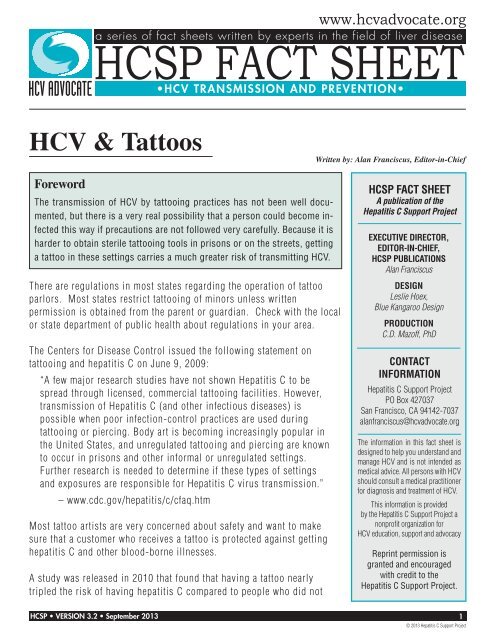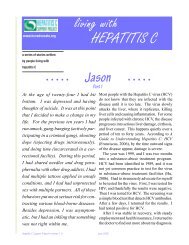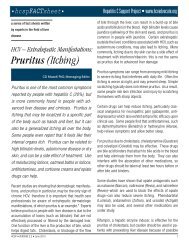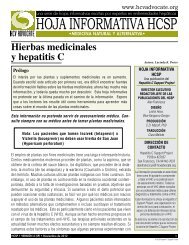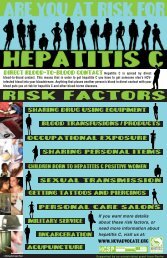HCV and Tattoos - HCV Advocate
HCV and Tattoos - HCV Advocate
HCV and Tattoos - HCV Advocate
You also want an ePaper? Increase the reach of your titles
YUMPU automatically turns print PDFs into web optimized ePapers that Google loves.
www.hcvadvocate.org<br />
a series of fact sheets written by experts in the field of liver disease<br />
HCSP FACT SHEET<br />
•<strong>HCV</strong> TRANSMISSION AND PREVENTION•<br />
<strong>HCV</strong> & <strong>Tattoos</strong><br />
Written by: Alan Franciscus, Editor-in-Chief<br />
Foreword<br />
The transmission of <strong>HCV</strong> by tattooing practices has not been well documented,<br />
but there is a very real possibility that a person could become infected<br />
this way if precautions are not followed very carefully. Because it is<br />
harder to obtain sterile tattooing tools in prisons or on the streets, getting<br />
a tattoo in these settings carries a much greater risk of transmitting <strong>HCV</strong>.<br />
There are regulations in most states regarding the operation of tattoo<br />
parlors. Most states restrict tattooing of minors unless written<br />
permission is obtained from the parent or guardian. Check with the local<br />
or state department of public health about regulations in your area.<br />
The Centers for Disease Control issued the following statement on<br />
tattooing <strong>and</strong> hepatitis C on June 9, 2009:<br />
“A few major research studies have not shown Hepatitis C to be<br />
spread through licensed, commercial tattooing facilities. However,<br />
transmission of Hepatitis C (<strong>and</strong> other infectious diseases) is<br />
possible when poor infection-control practices are used during<br />
tattooing or piercing. Body art is becoming increasingly popular in<br />
the United States, <strong>and</strong> unregulated tattooing <strong>and</strong> piercing are known<br />
to occur in prisons <strong>and</strong> other informal or unregulated settings.<br />
Further research is needed to determine if these types of settings<br />
<strong>and</strong> exposures are responsible for Hepatitis C virus transmission.”<br />
– www.cdc.gov/hepatitis/c/cfaq.htm<br />
Most tattoo artists are very concerned about safety <strong>and</strong> want to make<br />
sure that a customer who receives a tattoo is protected against getting<br />
hepatitis C <strong>and</strong> other blood-borne illnesses.<br />
A study was released in 2010 that found that having a tattoo nearly<br />
tripled the risk of having hepatitis C compared to people who did not<br />
HCSP FACT SHEET<br />
A publication of the<br />
Hepatitis C Support Project<br />
EXECUTIVE DIRECTOR,<br />
EDITOR-IN-CHIEF,<br />
HCSP PUBLICATIONS<br />
Alan Franciscus<br />
DESIGN<br />
Leslie Hoex,<br />
Blue Kangaroo Design<br />
PRODUCTION<br />
C.D. Mazoff, PhD<br />
CONTACT<br />
INFORMATION<br />
Hepatitis C Support Project<br />
PO Box 427037<br />
San Francisco, CA 94142-7037<br />
alanfranciscus@hcvadvocate.org<br />
The information in this fact sheet is<br />
designed to help you underst<strong>and</strong> <strong>and</strong><br />
manage <strong>HCV</strong> <strong>and</strong> is not intended as<br />
medical advice. All persons with <strong>HCV</strong><br />
should consult a medical practitioner<br />
for diagnosis <strong>and</strong> treatment of <strong>HCV</strong>.<br />
This information is provided<br />
by the Hepatitis C Support Project a<br />
nonprofit organization for<br />
<strong>HCV</strong> education, support <strong>and</strong> advocacy<br />
Reprint permission is<br />
granted <strong>and</strong> encouraged<br />
with credit to the<br />
Hepatitis C Support Project.<br />
HCSP • VERSION 3.2 • September 2013<br />
1<br />
© 2013 Hepatitis C Support Project
HCSP FACT SHEET<br />
<strong>HCV</strong> & <strong>Tattoos</strong><br />
•<strong>HCV</strong> TRANSMISSION AND PREVENTION•<br />
a series of fact sheets written by experts in the field of liver disease<br />
have a tattoo. However, the study showed that<br />
there was an association only – the actual mode<br />
of transmission wasn’t studied. 1<br />
We recommend only commercial tattoo<br />
parlors that practice the following<br />
precautions:<br />
• All single use items including ointments,<br />
tattoo ink, needles, gloves, trays <strong>and</strong> any<br />
other materials that come into contact<br />
with blood should be used only once <strong>and</strong><br />
discarded in a ‘sharps” bin or a punctureproof<br />
container.<br />
• Use disposable or new needles<br />
• Use separate ink pots<br />
• Reusable materials should be autoclaved.<br />
An autoclave is a machine that uses a<br />
combination of steam, pressure, <strong>and</strong> heat to<br />
sterilize equipment. There is an indicator<br />
on the autoclave machine to verify that the<br />
equipment has been sterilized. The tattoo<br />
shop should keep a record of the usage <strong>and</strong><br />
testing of the autoclave. Ask to check the<br />
records if there are any doubts about safety.<br />
• A new set of safety gloves are used for each<br />
person. The safety gloves should be changed<br />
if there is a possibility that the tattoo artist<br />
touched any surface.<br />
• The shop is clean <strong>and</strong> professional – floors,<br />
tables, <strong>and</strong> equipment should all appear clean<br />
<strong>and</strong> disinfected.<br />
• After the tattoo procedure, the tattoo artist<br />
will disinfect the work area with an EPA<br />
approved disinfection solution.<br />
Aftercare<br />
Another important prevention strategy is to<br />
make sure that care is given after the tattoo is<br />
HCSP • VERSION 3.2 • September 2013<br />
inked—since blood is involved it is important<br />
that the necessary steps are taken to prevent<br />
transmission of any blood borne illness. Your<br />
tattoo artist will give you instructions to care<br />
for your tattoo between visits or after the tattoo<br />
has been completed. Be sure to follow the<br />
instructions carefully <strong>and</strong> call your tattoo artist if<br />
you develop any type of infection or if you do not<br />
underst<strong>and</strong> any of the instructions.<br />
• The artists will apply a thin coat of ointment<br />
<strong>and</strong> b<strong>and</strong>age the tattoo to protect it—take off<br />
the b<strong>and</strong>age after one to two hours after being<br />
inked. This will help the healing process<br />
• Start to moisturize the tattoo after a couple of<br />
days using a fragrance-free moisturizer<br />
• Do not pick or scratch the tattoo – this could<br />
lead to bleeding <strong>and</strong> infection<br />
• Any signs of infection check in with your<br />
doctor <strong>and</strong> artist<br />
Check with friends for recommendations for shops<br />
that practice safe tattooing. Visit the tattoo parlor<br />
before committing to a tattoo <strong>and</strong> ask questions<br />
about safety procedures. Ask the artist or owner<br />
of the parlor if you can observe a customer getting<br />
a tattoo <strong>and</strong> check to make sure that the artist is<br />
carefully following the st<strong>and</strong>ard safety precautions<br />
listed above. If the artist is reluctant to answer<br />
questions about safety practices, shop around for<br />
another tattoo parlor that is more willing to talk.<br />
Another basic rule is to shop around for an artist<br />
based on their experience <strong>and</strong> knowledge <strong>and</strong> to<br />
stay away from any artist or shop that advertises<br />
“low-cost” or “bargain tattoos.” The price of the<br />
artist should be a reflection of their experience,<br />
knowledge <strong>and</strong> artistry.<br />
As consumers we should all be careful about<br />
safety practices <strong>and</strong> make it our responsibility to<br />
keep it safe.<br />
2<br />
© 2013 Hepatitis C Support Project
HCSP FACT SHEET<br />
<strong>HCV</strong> & <strong>Tattoos</strong><br />
•<strong>HCV</strong> TRANSMISSION AND PREVENTION•<br />
a series of fact sheets written by experts in the field of liver disease<br />
Reference:<br />
1<br />
Tattooing <strong>and</strong> the Risk of Transmission of Hepatitis C: A Systematic<br />
Review <strong>and</strong> Meta-Analysis by Siavash Jafarib, Ray Copesa, Souzan<br />
Baharlouc, Mahyar Etmin<strong>and</strong>, Jane Buxtona. Source: International Journal<br />
of Infectious Diseases published online August 3, 2010.<br />
For more information on hepatitis <strong>and</strong> tattoos check out the Hepatitis &<br />
<strong>Tattoos</strong> website: http://www.hepatitistattoos.org/<br />
• Americans with Disabilities Act<br />
www.ada.gov<br />
• Centers for Disease Control<br />
<strong>and</strong> Prevention<br />
www.cdc.gov<br />
Related publications:<br />
• <strong>HCV</strong> Transmission <strong>and</strong> Prevention Overview<br />
www.hcvadvocate.org/hepatitis/factsheets_pdf/Transm_preven.pdf<br />
• How Long Does <strong>HCV</strong> Live on Surfaces <strong>and</strong> in Syringes?<br />
www.hcvadvocate.org/hepatitis/factsheets_pdf/How_long.pdf<br />
• Preventing <strong>HCV</strong> <strong>and</strong> Transmission in Personal Care Settings<br />
www.hcvadvocate.org/hepatitis/factsheets_pdf/personal_care.pdf<br />
For more information<br />
• Mayo Clinic<br />
www.mayoclinic.com<br />
• MedlinePlus<br />
www.nlm.nih.gov/medlineplus<br />
Visit our websites to learn more about<br />
viral hepatitis:<br />
www.hcvadvocate.org • www.hbvadvocate.org<br />
www.hepatitistattoos.org<br />
HCSP • VERSION 3.2 • September 2013<br />
3<br />
© 2013 Hepatitis C Support Project


